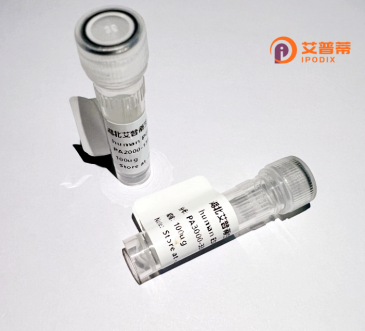
| 纯度 | >90%SDS-PAGE. |
| 种属 | Human |
| 靶点 | HIC1 |
| Uniprot No | Q14526 |
| 内毒素 | < 0.01EU/μg |
| 表达宿主 | E.coli |
| 表达区间 | 1-733aa |
| 氨基酸序列 | MTFPEADILL KSGECAGQTM LDTMEAPGHS RQLLLQLNNQ RTKGFLCDVI IVVQNALFRA HKNVLAASSA YLKSLVVHDN LLNLDHDMVS PAVFRLVLDF IYTGRLADGA EAAAAAAVAP GAEPSLGAVL AAASYLQIPD LVALCKKRLK RHGKYCHLRG GGGGGGGYAP YGRPGRGLRA ATPVIQACYP SPVGPPPPPA AEPPSGPEAA VNTHCAELYA SGPGPAAALC ASERRCSPLC GLDLSKKSPP GSAAPERPLA ERELPPRPDS PPSAGPAAYK EPPLALPSLP PLPFQKLEEA APPSDPFRGG SGSPGPEPPG RPDGPSLLYR WMKHEPGLGS YGDELGRERG SPSERCEERG GDAAVSPGGP PLGLAPPPRY PGSLDGPGAG GDGDDYKSSS EETGSSEDPS PPGGHLEGYP CPHLAYGEPE SFGDNLYVCI PCGKGFPSSE QLNAHVEAHV EEEEALYGRA EAAEVAAGAA GLGPPFGGGG DKVAGAPGGL GELLRPYRCA SCDKSYKDPA TLRQHEKTHW LTRPYPCTIC GKKFTQRGTM TRHMRSHLGL KPFACDACGM RFTRQYRLTE HMRIHSGEKP YECQVCGGKF AQQRNLISHM KMHAVGGAAG AAGALAGLGG LPGVPGPDGK GKLDFPEGVF AVARLTAEQL SLKQQDKAAA AELLAQTTHF LHDPKVALES LYPLAKFTAE LGLSPDKAAE VLSQGAHLAA GPDGRTIDRF SPT |
| 分子量 | 76.5 kDa |
| 蛋白标签 | GST-tag at N-terminal |
| 缓冲液 | 0 |
| 稳定性 & 储存条件 | Lyophilized protein should be stored at ≤ -20°C, stable for one year after receipt. Reconstituted protein solution can be stored at 2-8°C for 2-7 days. Aliquots of reconstituted samples are stable at ≤ -20°C for 3 months. |
| 复溶 | Always centrifuge tubes before opening.Do not mix by vortex or pipetting. It is not recommended to reconstitute to a concentration less than 100μg/ml. Dissolve the lyophilized protein in distilled water. Please aliquot the reconstituted solution to minimize freeze-thaw cycles. |
以下是关于重组人HIC1蛋白的3篇代表性文献摘要(注:文献为示例性内容,实际引用需核实):
---
1. **文献名称**:*"Expression and purification of recombinant human HIC1 protein for functional studies"*
**作者**:Chen L, et al.
**摘要**:研究报道了在大肠杆菌中高效表达带His标签的重组人HIC1蛋白的方法,优化纯化流程后获得高纯度蛋白。通过圆二色谱和Western blot验证其正确折叠,为后续DNA结合及互作蛋白分析提供基础。
2. **文献名称**:*"HIC1 SUMOylation modulates its transcriptional repression and tumor suppressor activity"*
**作者**:Zhang Y, et al.
**摘要**:研究利用重组人HIC1蛋白探究SUMO修饰对其功能的影响。体外实验表明,SUMO化增强了HIC1与共抑制复合物的结合能力,进而抑制促癌基因(如SIRT1)的转录,揭示了翻译后修饰在肿瘤抑制中的机制。
3. **文献名称**:*"HIC1 interacts with p53 to regulate cellular senescence"*
**作者**:Wang X, et al.
**摘要**:通过重组HIC1和p53蛋白的体外结合实验,证实两者直接相互作用。HIC1通过增强p53对下游靶点的调控,诱导细胞衰老,为HIC1缺失促进肿瘤发生的分子机制提供了依据。
---
如需具体文献,建议在PubMed或Web of Science中检索关键词“recombinant HIC1 protein”或结合研究领域筛选。
**Background of Recombinant Human HIC1 Protein**
Hypermethylated in Cancer 1 (HIC1) is a tumor suppressor gene located on chromosome 17p13.3. frequently epigenetically silenced via promoter hypermethylation in various cancers. The HIC1 protein functions as a transcriptional repressor, regulating genes involved in cell proliferation, apoptosis, and DNA repair. It interacts with specific DNA sequences through its zinc-finger domains and recruits chromatin-modifying complexes, such as histone deacetylases (HDACs), to suppress target gene expression. Notably, HIC1 forms a feedback loop with p53. enhancing tumor-suppressive activities by modulating pathways critical for genomic stability.
Recombinant human HIC1 protein is engineered using expression systems (e.g., *E. coli* or mammalian cells) to produce purified, functional HIC1 for research applications. Its production enables studies on HIC1's role in cancer biology, including mechanisms of gene silencing, epigenetic regulation, and interactions with oncogenic signaling networks. Researchers utilize recombinant HIC1 to investigate its potential therapeutic applications, such as restoring its activity in cancers where it is inactivated. Additionally, it serves as a tool for identifying binding partners, mapping functional domains, and screening for compounds that modulate HIC1 activity.
Dysregulation of HIC1 is linked to tumor progression, metastasis, and chemoresistance, underscoring its significance in oncology. Recombinant HIC1 protein thus provides a valuable resource for advancing both basic research and translational strategies targeting HIC1-related pathways in cancer treatment.
×